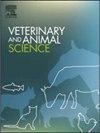Feline lymphoma associated with feline leukemia virus (FeLV) and feline immunodeficiency virus (FIV) infections in Brazil- Systematic review
IF 1.9
Q2 AGRICULTURE, DAIRY & ANIMAL SCIENCE
引用次数: 0
Abstract
Lymphoma is the most common neoplasia in cats and is frequently linked with concurrent retroviral infections. Despite preventive strategies, feline leukemia virus (FeLV) and feline immunodeficiency virus (FIV) remain endemic in many parts of the world, with FeLV significantly shortening the lifespan of infected cats. In Brazil and other low-income countries, the incidence of FeLV and FIV remains high. However, the distribution of these retroviruses across South America is still unclear, and their correlation with the anatomical and clinical features of feline lymphoma remains poorly understood. Gaining a deeper understanding of these associations could lead to more effective disease control strategies and better-defined chemotherapy protocols. In this study, we examined the geographical distribution and clinical presentations of feline lymphoma in retrovirus-positive cats in Brazil. A modified bias risk analysis assessed the quality of published studies, and a map was created to highlight areas in need of further research. Initial screening of 703 studies identified 29 relevant ones, encompassing 607 cats with feline lymphoma. After bias analysis, 273 cases were included in this review: 190 were FeLV-positive and FIV-negative, 98 were FeLV-negative and FIV-negative, and 15 were FeLV-negative and FIV-positive. Cases were reported from six Brazilian states and the Federal District of Brazil (2000–2023). The anatomical location of lymphoma varied depending on the cats' viral status, with notable differences in intestinal and mediastinal manifestations. FeLV-negative cats showed an 11.1-fold increased risk (95 % CI=6.0–20.0) for intestinal lymphoma, while FeLV-positive cases had a 7.5-fold increased risk (95 % CI=3.7–15.6) for mediastinal lymphoma. Due to the scarcity of FIV-related cases, analyzing associations was not feasible. Given the apparent association between FeLV-positive status and lymphoma location, further research into this neoplasm is strongly encouraged. We also recommend widespread retrovirus testing and expanded FeLV vaccination efforts in Brazil.
巴西与猫白血病病毒(FeLV)和猫免疫缺陷病毒(FIV)感染相关的猫淋巴瘤——系统综述
淋巴瘤是猫中最常见的肿瘤,通常与并发逆转录病毒感染有关。尽管采取了预防措施,猫白血病病毒(FeLV)和猫免疫缺陷病毒(FIV)仍然在世界许多地方流行,FeLV大大缩短了受感染猫的寿命。在巴西和其他低收入国家,FeLV和FIV的发病率仍然很高。然而,这些逆转录病毒在南美洲的分布仍然不清楚,它们与猫淋巴瘤的解剖和临床特征的相关性仍然知之甚少。对这些关联的深入了解可能会导致更有效的疾病控制策略和更明确的化疗方案。在这项研究中,我们检查了巴西逆转录病毒阳性猫的猫淋巴瘤的地理分布和临床表现。一项修正偏倚风险分析评估了已发表研究的质量,并绘制了一张地图,突出了需要进一步研究的领域。对703项研究的初步筛选确定了29项相关研究,其中包括607只患有猫淋巴瘤的猫。经偏倚分析,本综述纳入273例:felv阳性和fiv阴性190例,felv阴性和fiv阴性98例,felv阴性和fiv阳性15例。巴西6个州和巴西联邦区(2000-2023年)报告了病例。淋巴瘤的解剖位置因猫的病毒状态而异,在肠道和纵隔表现上有显著差异。felv阴性猫患肠淋巴瘤的风险增加11.1倍(95% CI= 6.0-20.0),而felv阳性猫患纵隔淋巴瘤的风险增加7.5倍(95% CI= 3.7-15.6)。由于fiv相关病例的缺乏,分析相关性是不可行的。鉴于felv阳性状态与淋巴瘤位置之间的明显关联,强烈鼓励对这种肿瘤进行进一步研究。我们还建议在巴西广泛开展逆转录病毒检测和扩大FeLV疫苗接种工作。
本文章由计算机程序翻译,如有差异,请以英文原文为准。
求助全文
约1分钟内获得全文
求助全文
来源期刊

Veterinary and Animal Science
Veterinary-Veterinary (all)
CiteScore
3.50
自引率
0.00%
发文量
43
审稿时长
47 days
 求助内容:
求助内容: 应助结果提醒方式:
应助结果提醒方式:


